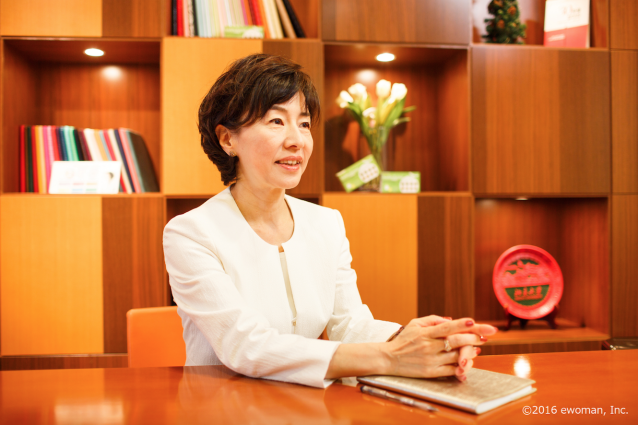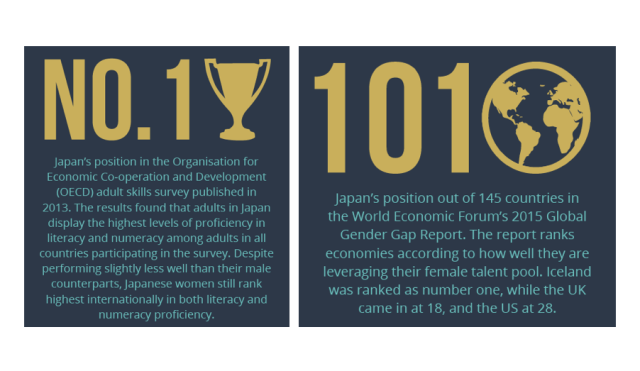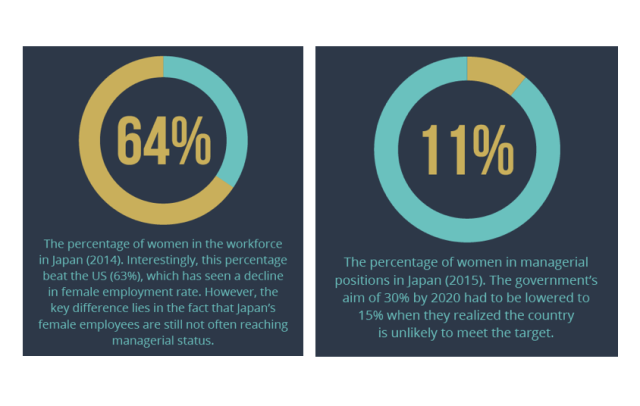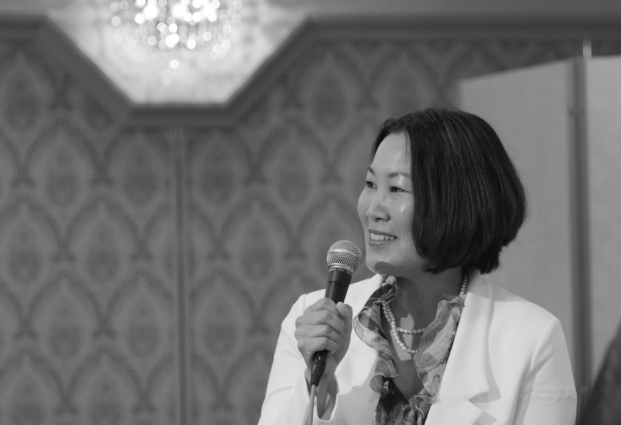We have a new quota law, a new female Tokyo governor, and a prime minister who has turned “womenomics” into a catchphrase. So why does it feel like we’re only skimming the surface of the gender equality issue? We chat to a host of influential women in Tokyo to ask their opinions on whether things are truly changing, and what still needs to be done as Japan enters its era of diversity.
“We cannot leave Tokyo to a woman with too much make-up.” This was just one of the ludicrous comments that marred Yuriko Koike’s historical win as Tokyo’s first female governor in the July elections. Uttered by former Tokyo governor Shintaro Ishihara, the comment was laughed off by Koike who claimed she was “used to it.” (One could almost imagine Koike chuckling together with Hillary Clinton and Theresa May while comparing the gender-based attacks they’ve each had to deflect.) But for the rest of the women in Japan – and the world, no less – who regularly face battles in the workplace against inequality and condescension, it surely felt like two steps forward one step back.
Her choice of make-up aside, Koike was also criticized for running for the position without getting the approval of Prime Minister Shinzo Abe’s Liberal Democratic Party (LDP). But there was not much else she could do. She’s in a male-dominated environment, and Abe chose not to endorse her – missing an ideal opportunity, we might add, to prove his talk of “womenomics” is more than just hot air. Ultimately, Koike had to blaze her own trail. Or as
Kaori Sasaki, CEO of both Ewoman and Unicul, might put it: Koike had to think big.
“Think Big” was the theme of this year’s International Conference for Women in Business, an event founded by Sasaki 21 years ago. The champion of female empowerment is also no stranger to pushing boundaries in her career, having stormed her way up the ladder from a position as news reporter for TV Asahi (during which she was shot in the leg while reporting from South Africa towards the end of apartheid – but that’s another story). Held in Tokyo shortly before the elections, the 2016 conference attracted a record 1,000 participants, with 12 percent being male (also a record). The theme, says Sasaki, was intended to inspire women to think about how they can jumpstart their careers. “Culturally, we have been taught to move one step at a time to work our way through the corporate system, but women need to feel that they can start thinking differently. They need to imagine something bigger for how they are going to move forward from now.”
Sasaki is not alone in her philosophy. One person who agrees with her is Paula Sugawara. She has lived and worked in Japan for 28 years, and is a trained executive coach and managing director of Lee Hecht Harrison, which specializes in outplacements and leadership development. “One of the programs we run is called Elevate Your Influence, and is aimed at helping women take charge of their career,” she says. Referencing the new quota law that took effect in April 2016 and requires companies to publicly disclose their plans for hiring more women in management positions, she goes on to say: “We can’t just wait for somebody to say, ‘Okay, we are hiring you because we need to meet the targets set by government.’ Women need to think about how they can move forward on their own.”
On the flipside, Sugawara notes that when some women do reach top positions, they sometimes end up overcompensating and becoming “monster managers.” “They become overly aggressive because they feel they need to prove themselves to male co-workers or bosses, and they lose the feminine leadership traits that are so valuable.”
Tokyo governor Koike, for one, has indeed been accused of being too aggressive. But unless Abe’s ambitious growth strategy is able to truly change the collective mindset, many women, like Koike, will find themselves stuck between a rock and a hard place. Bearing in mind, this is a mindset that has hardly shifted in the 30 years since the 1986 equal opportunity law was passed in Japan. In fact, the shift has been so slow that in 2003, the government set a target to increase the percentage of women in management positions to 30 percent by 2020. Since we’re not anywhere near to reaching this goal, Abe has added the additional quota law in the hope of prompting better results.
The problem, it seems, is that simply hiring more women doesn’t successfully address the underlying issues. According to the 2016 Global Gender Diversity Report by recruitment firm Hays, there are still fewer women aspiring to top leadership positions, and only 35 percent of female survey respondents in Japan said they felt they had opportunities to “self-promote” and communicate their ambitions in the workplace. Moreover, only 50 percent of the female respondents in Japan said that they believed they were being paid equally to their male peers. When you start out feeling like the task is impossible, it takes extraordinary strength to keep up the fight.
Etsuko Tsugihara, president of Tokyo-based PR firm Sunny Side Up (SSU) – which was placed 19th in the world (and 1st in Japan) in the Holmes Report Global Top 250 PR Agency Ranking 2016 – could easily be described as possessing such strength. She was 17 when she started SSU with her mother, and by her twenties, she was running the business. “As SSU grew, I realized how hard it is for a woman to lead a company in Japan. The male-dominant workplace was full of jealousy, and men constantly talked behind my back and tried to pull me down. It was a daily thing,” recalls Tsugihara. “However, I had been working since I was a teenager, and had experience to draw from, so I didn’t let it bother me. I became very insensitive to things; maybe that’s the reason I’ve been able to run the company for 32 years.”
SSU’s workforce is 55 percent female, and Tsugihara strives to promote an atmosphere where “women can work freely.” The company even has a “frozen egg policy,” which supports women who might want to delay getting pregnant in order to focus on their career. “In this way, we’re trying to reduce the worries of qualified career women who are considering when to have a child. In addition, we’ve created an environment where women can continue working after giving birth.”
Of course, not all women are built with the strength of Tsugihara, Sasaki, or governor Koike. We need to consider that many in Japan might feel a massive weight of expectation being placed on them as the country goes through a transition and enters this “era of diversity,”
as Sasaki terms it.
Kyoko Yukioko is a final-year student at Akita International University, and recently wrote her thesis on gender diversity. As she prepares to enter the job market in Japan, she expresses concern about the fact that the gender binary system and specific gender roles are still persistent in people’s minds. “Women have aimed for the Japanese ideal female image, often pictured in the household as wife or mother. There is a famous term for the traditional female ideal model called ‘ryo-sai kenbo,’ meaning ‘good wife, wise mother.’ But now we also have to meet society’s new expectations, and aim to be the ideal woman in the workplace too. I think women might struggle because society expects them to meet both the feminine, beautiful, wife-and-mother image, as well as the hardworking, devoted, career-woman image.”
Even though it makes perfect economical sense to willfully employ and promote the well-educated but underutilized female population, it’s crucial to find the delicate balance between giving women opportunities and changing a system that’s been in place for decades. For example, if women are to be encouraged to return to work after having a child, companies need to ensure that the working moms are not relegated to a more junior, menial role upon their return – which is common in Japan and leads to a large number of women simply staying at home.
This is proven to still be the case as recent statistics released by Japan’s Gender Equality Bureau Cabinet Office showed a clear dip in women’s labor force participation after the age of 30. On a graph comparing Japan to other developed countries, Japan was the only country to still show this M-shaped curve. On this note, Paula Sugawara stresses the importance of creating a reskilling program for women who may have been out of the workforce for many years but wish to return. “A lot of it is about confidence,” she says.
Probably the biggest change that needs to happen is in the males’ mindset and working habits, says Sasaki. “I like to joke that we have too many gentlemen in Japan,” she says, smiling. “By this I mean that we have many laws and policies that are kind towards women, such as equal opportunity, maternity leave, and flextime. For the last 30 years, these laws have been used mainly by women, which means that men haven’t changed their way of working. They still put in long hours, and end up sacrificing their time with their family, and not being able to help out at home. But they work these long hours because they believe they won’t get promoted otherwise.” Change needs to filter through from the top down so that men and women are not only given equal opportunities in the workplace, but are seen as equally responsible for childcare, and equally entitled to leave work on time without being made to feel they are sacrificing their future career.
Janelle Sasaki, the executive director of Diversity & Inclusion Services at Ernst & Young Advisory Japan, says there are three key areas to focus on in order to encourage women’s advancement: “Visible career opportunities, flexible working arrangements, and building a supportive workplace by reducing unconscious bias.” A large part of Janelle’s role entails helping companies figure out how to leverage diversity and inclusion for business growth and innovation. “Diversity is the what, and inclusion is the how. Inclusion is when employees feel supported, welcomed, listened to, and accepted. When companies hire diverse talent, and that talent feels included and part of one team, there is greater employee engagement and satisfaction. Companies need to leverage both diversity and inclusion to be successful and tap into the human potential – this leads to greater opportunity to innovate and a better impact on the bottom line.”
It’s also important for women to find supporters amongst each other. Groups such as For Empowering Women (FEW) in Japan offer regular events aimed at helping women to achieve their personal and professional potential. “We strive to provide a platform where women of all backgrounds can connect through workshops and networking events. We focus our monthly meetings on providing opportunities where the attendees can learn from speakers and each other, share their experiences, and go away with concrete tips that they can put into practice,” says the group’s president, Sarah Achilles.
FEW’s PR and communications director Jodi Harris adds: “When women come together across cultural lines, we’re stronger and better able to advocate for each other’s needs, whether it’s something like asking for a raise, or addressing the way women are perceived. In addition to the topics covered, the energy created at the meetings by all of us coming together is what is so valuable.”
Finally, we turn to Kaori Sasaki to ask how women can better deal with any gender-based discrimination they might face at work. With her characteristic blend of pragmatism and humor, she says, “You should never say that you’ve been at a disadvantage because you’re a woman. It’s better to believe that if you’ve missed opportunities it’s because of something else, like a bad presentation. Because if you start to think that you are not good enough or not given opportunities because of your gender, then you are giving up. Unless you change your gender, right?”
This article appears in the September 2016 issue of Tokyo Weekender magazine.













